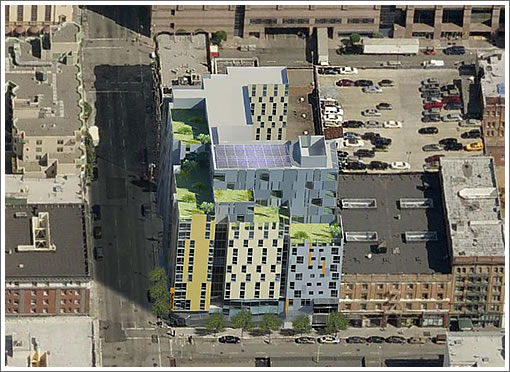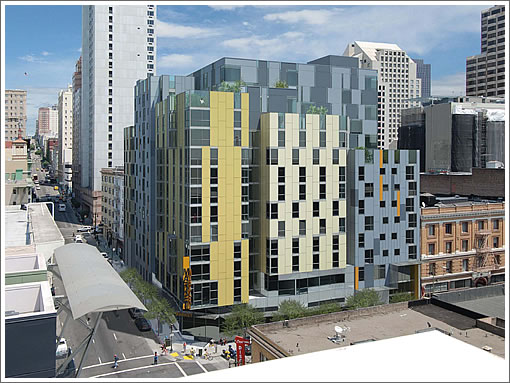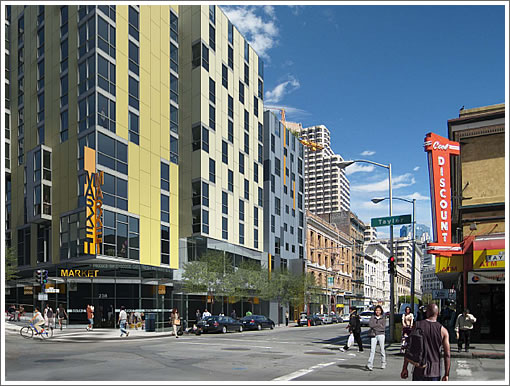
Approved for development in 2009 but stymied by “the continuing poor fiscal conditions of local, State, and Federal government, and the associated difficulties in securing financing for an affordable housing project,” the Tenderloin Neighborhood Development Corporation is seeking a five year extension of their three year performance period to demolish the surface parking lot at the corner of Taylor and Eddy and construct a 14-story building with 153 affordable dwelling units over 13,750 square feet of ground-floor commercial space.

The Mayor’s Office of Housing provided $5.9 million to acquire the 168-186 Eddy Street site in 2007, David Baker + Partners was drafted for the design, and the commercial space is still slated to become the first full-service grocery store in the Tenderloin.

Good. That building is ugly as fu….
Good lord, sell the building to a market-rate developer. If now does not have good “fiscal conditions” for new housing, I don’t know what would be considered good – rent increasing at 50% per year?
This is the kind of thing that the Americas Cup is supplanting.
I’ve seen better and worse with respect to the design but the delay in developing this site is anything but good. The delay won’t change the design but does leave the neighborhood without a proper grocery store and 153 units for at least another five years.
I do wish they would start building market rate housing rather than affordable developments in the Tenderloin, I think that’s what the neighborhood needs to turn the corner and start cleaning itself up and the money could be used to finance other housing and infrastructure projects.
I thought this building violated the shadow ordinance?
And it was proposed in 2009. Isn’t the economy much better now an it was then?
I thought this building violated the shadow ordinance?
At the Planning Commission hearing on March 26, 2009 at which the devlopment was approved, the Commission granted modifications of Planning Code requirements related to bulk, height measurement, streetwall setbacks, rear yard, dwelling unit exposure, and off-street parking (of which there will be none).
The Commission also adopted a joint resolution with the Recreation and Park Commission to raise the absolute cumulative limit for additional shadow on Boeddeker Park from zero percent to 0.244 percent, an amount sufficient to accommodate the net new shadow cast by the Project.
And upon the recommendation of the General Manager of the Recreation and Park Department, the Commission then found that the additional shadow cast by the Project on Boeddeker Park would not be adverse, and allocated the additional shadow to the Project.
I have to agree with Michael. TL needs more market rate housing, not BMRs, nor SROs. I’m sick of this idea that it’s a stronghold for the less fortunate. Distribute the BMRs across all neighborhoods rather than concentrate them where it becomes socially acceptable to be filthy and loud. That, and dismantle the TNDC, which is a shameful bunch of corrupt individuals profiting on the poor.
How long does it take to demolish a surface parking lot?
i don’t mind the concentration of bums/urine/public housing in one area if it wasn’t in plop center of the city right next to otherwise nice areas and also where you must pass through to get anywhere.
Hey anon, Michael and kg, you all should start reading socketsite.
First, what makes you think that a commercial developer would be able to obtain sufficient financing to produce a market rate project at this location? It is just obvious to you that market rate units at this location would pencil out? It isn’t to me, but perhaps I’m missing something.
Second, “distribute the BMRs across all neighborhoods?” In case you haven’t been reading socketsite, existing residents in the more hoity-toity neighborhoods don’t want affordable dwelling units in their areas and developers, more often than not, prefer to pay the in lieu fees rather than build affordable units on site.
How often have you seen a project where among the first comments in the ss thread is, “why is [insert agency here] building in this neighborhood when they could have built more units for the same money if they built in the ‘loin?”
Don’t get me wrong, I’d love to live in the alternate reality you inhabit where improvable land can be acquired for similar amounts of money in “all neighborhoods” and there are no NIMBYs in said neighborhoods who can and do obstruct new development, particularly when “affordable dwelling units” are involved that might bring what upper class people call “the undesireable element” into the places where they live.
But that’s not the one I see and read and hear about right now.
I thought this building violated the shadow ordinance?
And it was proposed in 2009. Isn’t the economy much better now an it was then?
Can someone simply explain what the shadow ordinance is?
Never heard of this before!
Approved for development in 2009 but stymied by “the continuing poor fiscal conditions of local, State, and Federal government, and the associated difficulties in securing financing for an affordable housing project,” the Tenderloin Neighborhood Development Corporation is seeking a five year extension of their three year performance period to demolish the surface parking lot at the corner of Taylor and Eddy and construct a 14-story building with 153 affordable dwelling units over 13,750 square feet of ground-floor commercial space.
Umm drive down El Camino Real from Daly City to San Mateo and Belmont-San Carlos. Lots of projects going up just like this. In fact I see one being built around ECR and The Orange Avenue area by the High School right now.
condoshopper: the concentration you “don’t mind” ensures that it will always be next to something “nice.” The only way to get rid of the ghetto is to stop forcing them to exist.
David Baker + Partners… Oy Vey.
at 11:12 AM, I wrote:
…and I want to substantiate that. I was referring to a report distributed in January of this year by The City’s budget and legislative analyst.
Here’s a report on the situation from The Bay Citizen, More SF Builders Opting Not to Include Affordable Housing, money ‘graphs:
Emphasis mine. The “elsewhere” is locations like this one, where land is relatively cheap and the resulting completed units can be, too.
Please someone defines “affordable housing” for me.
By definition, if a market rate place has a buyer or renter, then that someone can obviously “afford” this place.
Right?
[ /removes tongue from cheek ]
Here’s a relevant couple of ‘graphs from John King’s column of May 23rd, Transbay plan – is new skyline worth more shadows?, regarding another building that may run afoul of the shadow ordinance, the proposed 61-story Transbay Transit Tower:
Emphasis mine. I’m assuming that King is referring to Proposition K, The “Park Shadow Ban” here and not some other shadow-regulating legislation that I’m not familiar with.
Hope that helps.
Editor’s Note: Or as we first reported: Shining Light On The Shadows Of The Proposed Transit District Towers and Sue Hestor Seeks To Stop Transit Center Tower Development Short.]
First, what makes you think that a commercial developer would be able to obtain sufficient financing to produce a market rate project at this location? It is just obvious to you that market rate units at this location would pencil out? It isn’t to me, but perhaps I’m missing something.
We’ve got like 3000 units under construction in the mid-Market area? That area is probably less desirable than this would be for market-rate, so yes, I have zero doubt that any number of private developers could very, very, very easily obtain financing for 150 new apartments here.
what poor market conditions??? Oh right, the poor conditions created by the Bay Area’s own BS.
http://www.slate.com/blogs/moneybox/2012/07/16/homeless_in_silicon_valley.html
“In May, the median value of a house in Palo Alto was more than $1.34 million, up 11.5% from $1.2 million a year earlier, Zillow says. Rents in June were up as much as 30% from the previous year and are at an all-time high, according to a monthly report compiled from landlord advertisements by Palo Alto Realtor Leon Leong.
…
Silicon Valley should be the site of tons of working-class construction jobs and a big population boom. Qualified engineers from around the country should be moving there and pushing the frontiers of innovation, with the population growth and construction also supporting employment all up and down the skill spectrum. Doctors and nurses and teachers and retail-store clerks and chefs and busboys and carpenters and plumbers and used-car salesmen and all God’s wonderful creatures. But instead faced with NIMBYs and restrictive zoning, we’re seeing modest population growth, double-digit housing price increases, falling real earnings for the working class, and a boom in homelessness. It’s absurd, and it’s tragic.”
[Editor’s Note: The density discussion and related comments have been moved to: It’s All About (A Lack Of) Density.]
That would be the same TNDC that had no problem with a pot club opening in the ground floor of their substance abuse rehab SRO. No lie. The joint is whack, Jack.
In a short time, we have seen dramatic changes in the world of affordable housing financing. The elimination of Redevelopment Agencies stripped $50 million of annual subsidy from San Francisco, and combined with State budget problems and long-term Federal deficit reduction, nonprofits’ ability to develop affordable housing faces more constraints now than any other time in the past 30 years. At the same time, the main sources of income for our senior and disabled residents—social security and disability—have been reduced multiple times.
Against this backdrop, San Francisco has become the most expensive rental market in the nation (http://www.huffingtonpost.com/2012/03/14/san-francisco-rents-the-highest-in-nation_n_1345275.html). While the economy is improving, this has not trickled down to affordable housing financing. The private real estate market cannot build for low income people profitably, so for San Francisco to remain a city for all – families and workers, not just the privileged – we cannot look to market rate developers to fulfill the need.
As a result of shrinking public resources, TNDC is thinking differently about how to finance affordable housing, and we are working on mixed-income developments at four different sites. Having shopped the site at the corner of Eddy and Taylor to multiple market-rate developers as potential joint venture partners, however, we know that new construction market-rate housing is not yet financially feasible there…though it’s a lot closer than it was a year ago, and we think we will ultimately succeed. Sites South of Market are significantly more viable than in the Tenderloin from a market-rate development standpoint.
“Affordable housing” is typically defined as rents of 30% of the area median income for people earning no more than 60% of the area median income, adjusted for household size. In real-life terms, that means maximums of about $42,000 for an individual and $62,000 for a 4-person household.
TNDC has never opened a pot club in the ground floor of an SRO; perhaps someone is getting us mixed up with another organization.
For full disclosure, I am Don Falk, Executive Director at TNDC.
“The private real estate market cannot build for low income people profitably”
They could, if it wasn’t so difficult to build in SF. More density and more units means lower prices. It’s not rocket science.
If, as Don Falk posted above. San Francisco is now America’s most expensive rental market, the city that spends its time worry about parklets, mobile park benches (Parkmobiles), closing streets to cars for bike lanes and calculating building shadows should REALLY spend a little more time on the real problems of the city which are affordable housing, MUNI, dirty streets, vandalism-crime-safety, and of course the homeless population. Talk about bread and circus politics! How many meetings are going to be held where people voice their anger over whether or not Market street should be closed to private vehicles when what should be discussed regarding Market is increased density and street safety. Instead we get solar powered kiosk proposals. If I can live in a pedestrian friendly beachfront neighborhood in San Diego for 1/4 the cost of “the city” as we love to call San Francisco, why am I noticing more and more that San Francisco feels not so special as it did when I first arrived.
Since Don Falk says that they’ve been very close to signing up market rate developers to do a combo deal at this location, it seems completely obvious that a market rate developer would have less than zero problem lining up financing for a 100% market rate development.
Let’s do it – the Tenderloin needs more market rate housing more than any neighborhood in the city. While we’re at it, let’s upzone the lot for another 15 stories.
If I can live in a pedestrian friendly beachfront neighborhood in San Diego for 1/4 the cost of “the city” as we love to call San Francisco
What neighborhood would that be? Certainly not La Jolla, Pacific Beach, Mission Beach or Ocean Beach.
Unless you are comparing OB to Pac Heights, which would be kind of silly.
If, as Don Falk posted above. San Francisco is now America’s most expensive rental market, the city that spends its time worry about parklets, mobile park benches (Parkmobiles), closing streets to cars for bike lanes and calculating building shadows should REALLY spend a little more time on the real problems of the city which are affordable housing, MUNI, dirty streets, vandalism-crime-safety, and of course the homeless population.
The other day on the Bay Area News. We only get KTVU Channel 2 at the Lake for some weird reason. They said Palo Alto has the 2nd highest rents in the country. #1 is NYC